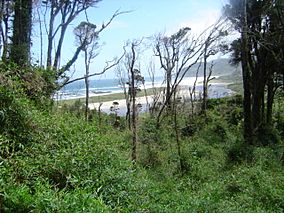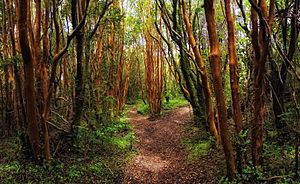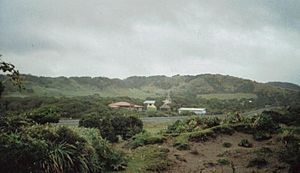Chiloé National Park facts for kids
Quick facts for kids Chiloé National Park |
|
|---|---|
|
IUCN Category II (National Park)
|
|

Abtao, Chiloé National Park
|
|
| Lua error in Module:Location_map at line 420: attempt to index field 'wikibase' (a nil value). | |
| Location | Los Lagos Region, Chile |
| Nearest city | Chonchi |
| Area | 431 km² |
| Established | 1983 |
| Governing body | Corporación Nacional Forestal |
Chiloé National Park is a beautiful national park in Chile. It is located on the western coast of Chiloé Island in the Los Lagos Region, which is known as the "region of the lakes."
The park covers a large area of about 430.57 km2 (166 sq mi). It is split into two main parts. The smaller part, called Chepu, is near the town of Ancud. The larger part, called Anay, is found near the towns of Dalcahue, Castro, and Chonchi. Most of the park is in the lower parts of the Chilean Coastal Range, which is also known as the Cordillera del Piuchén.
Inside the park, you can find many different types of landscapes. These include sandy dunes, thick Valdivian temperate rain forests, wet swamps, and spongy peat bogs. There's also a tiny island called Metalqui, which is part of the park. It's only about 0.5 km2 (0.19 sq mi) in size.
Contents
History of Chiloé National Park
Chiloé National Park was officially created in 1982. This happened through a special Chilean law called Supreme Decree N° 734.
When the park was first made, it was even bigger. However, some areas that were originally part of the park later became places where people lived. Because of this, the park's size was reduced by more than 45 km2 (17 sq mi).
Weather and Climate
The weather in Chiloé National Park is generally wet and mild. The average temperature throughout the year is about 11 °C (52 °F). It rains a lot here, and the rain is spread out evenly across all months.
The amount of rain can change depending on how high up you are. For example, along the Pacific coast, over 3,000 mm (120 in) of rain falls each year. In the higher parts of the Piuchén mountains, it can rain almost 5,000 mm (200 in) annually! But on the eastern slopes, which are in a rain shadow (meaning they get less rain), only about 2,500 mm (98 in) of rain falls each year.
Amazing Plants of the Park
The main type of plant life you'll see in Chiloé National Park is the Valdivian forest. This is a very dense forest filled with trees that stay green all year round. You'll also find many shrubs and climbing plants.
These rainforests are home to evergreen southern beech trees, also known as Nothofagus. There are also some native conifer trees, like the magnificent alerce (Fitzroya cupressoides). In the hills, you'll discover large areas of bogs and swamps. The Chilean rhubarb plant is also very common throughout the park.
Wildlife in Chiloé National Park
One of the most famous things about Chiloé Island and the Gulf of Corcovado is the presence of pygmy blue whales. These amazing creatures have special feeding grounds here. In fact, there are only about four known feeding spots for pygmy blue whales and blue whales in the entire Southern Hemisphere, and the Chiloé region is one of them!
It's really cool that these whales often swim into the narrow fiords (long, narrow inlets of the sea) in this area. They do this either to find food or to rest. This region is also an important home for other types of whales. These include humpbacks, finbacks, and seis. It might even be a habitat for the critically endangered southern right whale, of which there are only about 30 left from the Peru/Chile stock. You can sometimes see whales close to the shore on the southern side of the island, for example, near Caleta Zorra.
Images for kids
See also
 In Spanish: Parque nacional Chiloé para niños
In Spanish: Parque nacional Chiloé para niños




